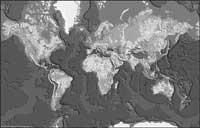World atlas of artificial light

Among the photographs of the Earth taken by satellite, those showing artificial night light are well known. If we look at them, we can pick up some idea of light pollution. Pierantonio Cinzano and Fabio Falchi, of the University of Purdue (Italy), wanted to obtain more precise data to process the data collected by the military meteorological satellites DMSP, in order to analyze the propagation of artificial light in the atmosphere.
With this information, they have produced the first world atlas that collects the brightness of artificial light in the night sky. According to this, many areas that appear dark in satellite photographs are also affected by the light pollution of their surroundings. According to data from 1996 to 1997, two-thirds of the world population and 99% of residents in Western Europe and the continental U.S. have no access to a completely starry sky. This data will probably be more severe today.
Buletina
Bidali zure helbide elektronikoa eta jaso asteroko buletina zure sarrera-ontzian











